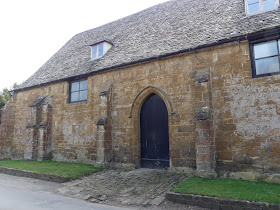A record of wildlife in my garden and various trips to the Warwickshire countryside and occasionally further afield.
Friday, 29 March 2019
Adderbury - Part 3: A Walk around the Village
Before going to Adderbury I'd found a useful Village Trail online showing various points of interest in the village. We did visit places in a slightly different order as we started the trail by the church rather than the Village Green and also got sidetracked with having lunch and visiting Adderbury Lakes.
The village was picturesque with all of the charm of a Cotswold village but without the hordes of tourists! :) D said it was one of the loveliest villages we had visited.
When we arrived we parked by the library near the church. The library or Church House was the village girls' school between 1832 and 1962.
The Grange Manor - the present building dates mainly from 1684 but does retain some earlier features. It was originally the medieval rectory and it is believed there is a passage leading to the church. During the Civil War the rector, Dr Oldys, who was a royalist was killed by parliamentarian troops.
The Old Vicarage built in the 16th and 17th centuries but altered in the early 18th century.
Rawlins House once the Grammar School endowed by the will of the Reverend Christopher Rawlins in 1589.
A market took place on the village green from 1218. There used to be stocks and a whipping post here and until 1623 a cross.
The Red Lion.
Lesser Celandine flowering on the grass verge.
The Tithe Barn - parts of which date back to the 13th century.
The Bell Inn - with 3 pubs in the village you are spoilt for choice when it comes to eating.
The Wesleyan Chapel
Prices at the Coach and Horses where we had lunch.
The gateposts of South House and The Orchard (seen in the picture below) are all that remain of Cobb Manor originally built by William Cobb in 1582. Following the death of Sir George Cobb in 1762 it was leased by tenants and gradually deteriorated falling into ruins by 1815.
The Rookery is a three gabled Jacobean house and the main part of the building dates back possibly to the 15th century. The house contains a priest hole and wall paintings dating back to the Civil War.
After going down a little alley way I had problems finding Ivy House which was the home of Fanny Buck (1869 - 1945) who was the last of the Adderbury Quakers to wear traditional Quaker clothes. I am pretty sure this is the house.
Past the church you arrive at the gates of the old Manor House parts of which date back to the 16th century. No photo of the house as I didn't like to just wander down the drive!
Walking down Mill Lane you arrive at Adderbury Mill which was a working mill until the 1930's. The Duke of Argyll had the mill re-positioned here in the mid 1700's as the original location spoilt the view of his grounds at Adderbury House!!!
In the late 17th century Adderbury village was a stronghold for Quaker dissent with 27 family names recorded as Quakers.
In Adderbury Cemetery is The Friends Meeting house built in 1675 at Bray Doyley's (Lord of Adderbury West) expense. The number of Quakers in the village began to decline from the late 18th century.
Quaker Graves
This is the gravestone for Fanny Buck mentioned above.
*D
*D
*D
*D
*D
*D
By Colin Butler Green are two manor houses -
Le Halle Place - parts of the manor date back to the 16th century and earlier. However, large windows added in the 19th century have somewhat altered its appearance.
*D
Little Manor - home to Bray Doyley (mentioned above). He was an influential Quaker and was imprisoned for his beliefs.
*D
*D
This little cottage called The Leys is a rare example of the smallest type of village cottage with "one up and one down"
*D
*D
A photo of Banbury which D took on the drive home.
*D
*D Photos taken by my son with the Canon SX50HS bridge camera
Rest of photos taken by me with the Panasonic Lumix FZ330 bridge camera
Reference: Adderbury Village Trail information.


































































